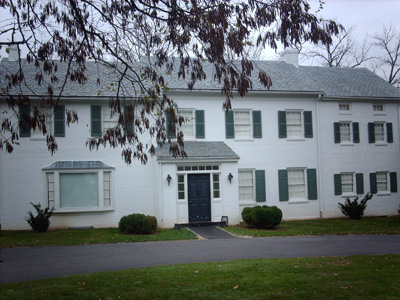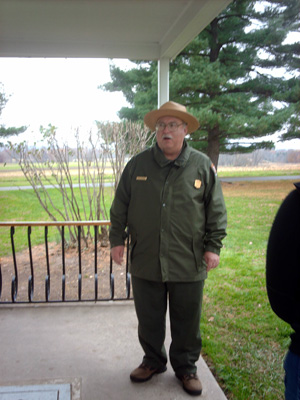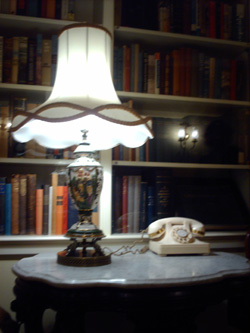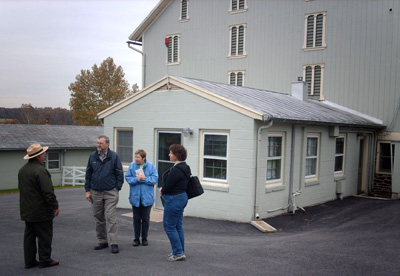
Eisenhower home is Gettysburg bonus
GETTYSBURG, Pa.— Alongside the Gettysburg Civil War battlefield, a long path surrounded by parallel lines of trees leads to the home of former President Dwight D. Eisenhower and his wife, Mamie.
Eisenhower was originally from Texas, but grew up in Kansas. His first encounter with Gettysburg was in 1918 when he was appointed Commander of Camp Colt, Army tank Corps training center. He liked the area so much that he decided to come back with his wife years later.
 |
The exterior and front entrance of the home of former President Dwight D. Eisenhower (Photo by Jessy Schuster). |
The 34th American president purchased the farm in 1950 as a retreat after retiring from his military career and his service as a commanding general of the U.S. Army during World War II. But Eisenhower’s political career started one year later when he became the first Republican president in 20 years.
The Eisenhower farmhouse was the only couple’s home after eight years in the White House and it became a gathering place for the family and a secondary office during time of illness.
Eisenhower suffered a heart attack in 1955 and converted his home into a temporary White House where foreign dignitaries, such as President Charles de Gaulle of France and Premier Nikita Khrushchev of the Soviet Union, visited.
The 230 acres of land were deeded by the couple to the United States in 1967 to be administrated by the National Park Service as the Eisenhower National Historic Site. The house was given without its content, but Eisenhower’s son donated all of the artifacts.
The site is separated into two farms and the Eisenhower home. The shuttle bringing visitors from the Gettysburg National Military Park Visitor Center stops in front of the former Secret Service office.
A park ranger dressed in dark green uniform welcomes visitors and takes them on a short orientation tour in the facilities around the house.
Rick Lemmers, who has been a park ranger on the site for 18 years, explained the purpose of the red light standing on top of the Secret Service office.
“When the agent was stepping out the office, the light turned on when the phone was ringing,” said Lemmers.
Adjacent to the office, the first barn was built in 1887 and was painted in white and Army green by
 |
Ranger Rick Lemmers talks to visitors at an entrance of the home of former President Eisenhower (Photo by Jessy Schuster). |
Eisenhower. Lemmers showed the different farm equipment still inside the barn, such as manure spreaders.
The farm was purchased for $44,000 with the equipment included, which was considered an “outrageous price at the time,” Lemmers said with a laugh.
On the left of the walking path to the main home, a putting green built in the 1950s reminds visitors of Eisenhower’s passion for golf. Before reaching the main attraction of the site, Lemmers narrated the story of the guest house where British Field Marshall Bernard L. Montgomery stayed.
The orientation tour ends at the entrance door of the Eisenhower home. Visitors turned the door knob silently like they did not want to disturb the occupants. The low lighting set an intimate mood that made visitors feel like they were about to meet the president and his wife at the corner of each room.
Time seemed to have stopped inside the house. From the wallpaper purchased in 1955 in the entrance hall to the former first lady’s perfume and outfits in her bedroom and bath, the house seemed so authentic that it felt as the Eisenhower family stepped out for the day.
Laura Gregory, 47, of Philadelphia, visited the site for the first time.
“It is very interesting and historical,” said Gregory. “I like visiting places presidents have lived in. My favorite part of the house is Mamie’s room. It is very pretty and feminine.”
Each visitor received Eisenhower Home Guide at the entrance of the house for a self-guided tour. Janet Brown, a former teacher, who has been working as a guide for the house for four months, shared her enthusiasm for the atmosphere of Gettysburg. She explained to visitors the importance of the Eisenhower’s formal living room.
“The room showcased the gifts the Eisenhowers received from heads of states as well as friends,” said Brown as she pointed to a painting of Prague, which was offered by a citizen to the president at the end of World War II.
 The site also features tours for student as part of the Teaching with Historic Places Program. As visitors walked to the second floor of the house, the entrance door opened to a dozen of children wearing military hats.
The site also features tours for student as part of the Teaching with Historic Places Program. As visitors walked to the second floor of the house, the entrance door opened to a dozen of children wearing military hats.
Their teacher, Mary Kueberth, explained that Eisenhower is studied in school as a role model for a character development program.
During the day trip to the site, Sarah Bishop, 9, of Frederick, Maryland, shared her excitement.
“There is a humungous living room! They have really nice bathroom, too. I would like to live here,” said Bishop, laughing.
While struggling between the numerous children on the two floors, visitors enjoyed Mamie Eisenhower’s personal touch to the house such as her passion for the color pink, which is featured in her master bedroom and bathroom.
The most surprising part of the house is its simplicity.
Carol Hegeman, the supervisory historian of the site, explained that “most people are just amazed that even if there are some nice rooms, it is very much a down to earth house.”
“They almost come expecting it to be more like a palace, said Hegeman. “But they realize it is like a home they could live in.”
Hegeman explained the secret behind the authenticity of the house.
“We are very lucky because in the 1950s period, photography was quite common,” said Hegeman. “Because he was a president, many events were photographed here. So we can use those historic photographs to see how the site evolved. You really see the house the way it was when they lived there. You get a feeling like they just stepped away.”
| A ranger interprets the former Secret Service office outside the home of former President Eisenhower (Photo by Jessy Schuster). |  |
The site is visited by 60,000 people annually. It used to be 100,000, but Lemmers explained that “the number has gradually gone down because the World War II generation is gradually passing off the scene as each day thousand of veterans dies. That was the generation relating to Eisenhower.”
The next generation of national park visitors looked very interested by the history of the house. Most children who visited the house were amazed by the numerous rooms and the president’s life.
Akua Asante, 10, visiting with her classmates from Frederick, Maryland, said that “It was a very fun trip because we learned about Eisenhower and his wife.” She recalled learning about Eisenhower’s knee injury while playing baseball.
As visitors stepped out of the house to return to the bus, some passed by once more in front of the Eisenhowers’ favorite room, the porch, where an unfinished painting by the former president still stood on an easel. Like most of the objects in the house, the painting of the Culzean Castle, Scotland, seemed to have been touched by its owners just minutes earlier.
If You Go
Eisenhower National Historic Site
- 250 Eisenhower Farm Dr., Gettysburg, Pa., 17325, 717-338-9114, ext. 10, http://www.nps.gov/eise/
- Tickets must be purchased at the nearby Gettysburg National Military Park Visitor Center:
- Fees: Adults (17 years and older), $ 5.50 in 2006 and $ 6 in 2007, children (13 to 16 years of age) $4 in 2006 and $4.50 in 2007, children (6 to 12 years of age) $3 in 2006 and $3.50 in 2007.
- Days and hours of operation:
Open daily from 9 a.m. to 4 p.m. The site is closed for Thanksgiving, Christmas and New Year’s Day.
Directions:
- Visitors arriving from the north and south can use U.S. 15. From the east and west, visitors can use U.S. 30. Shuttle buses to the site depart from the Gettysburg National Military Park Visitor Center, approximately one mile south of Gettysburg on S.R. 134 (Taneytown Road), and business route U.S. 15 (Steinwehr Avenue).
- Due to a lack of on-site parking and space limitations in the Eisenhower home, visits can only be made by a shuttle bus leaving from the Gettysburg National Military Park Visitor Center. The Center opens at 8 a.m. Tickets may be purchased on a first-come, first-served basis for the next available tour.

Comments are Closed